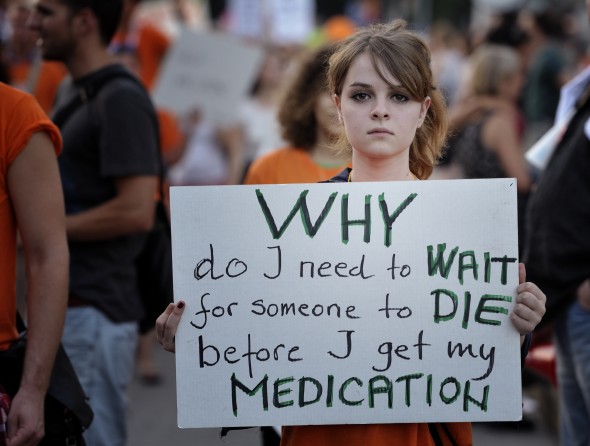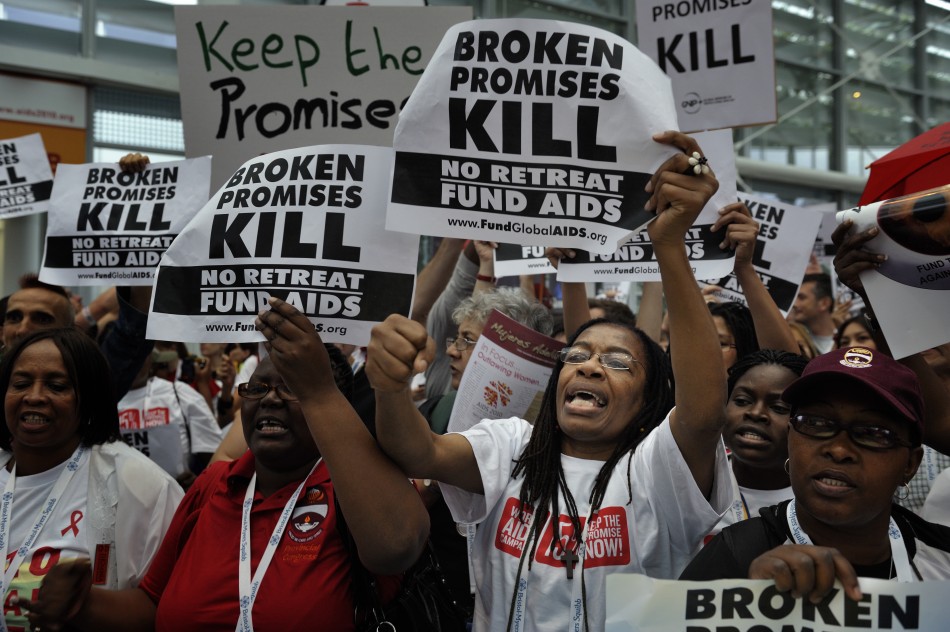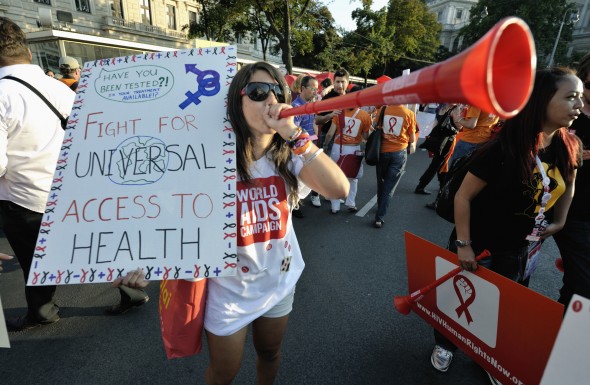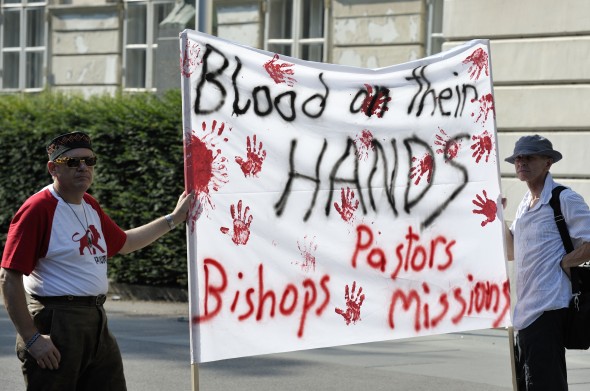Global Lens Reflections on life, the universe, and everything
AIDS Conference in Vienna
I’ve been to some pretty rough places over the years, and I know they’re rough because every once in a while I get to go someplace really pleasant. Like Vienna, where I spent the last week. I didn’t have much time to wander around, but did get out with some colleagues the last night to eat in the Reichenberger Griechenbeisl, a medieval building tucked back among narrow streets in the old city. Enchanting. (Details: I had the trout. Singer Annie Lennox ate two tables away from us.)
Most of the week I spent at the XVIII International AIDS Conference. It’s the third IAC I’ve been to, and it’s easily overwhelming. Some 19,000 researchers, UN and government officials, activists, policy wonks, pharmaceutical reps and miscellaneous big shots come together to engage in a dialogue that’s part scientific mumbo jumbo (T-cells, receptor sites, virus reservoirs), part treatment strategies (the efficacy of circumcision in reducing male vulnerability, the development of microbicidal gels for women, the nuances of behavior change), and part reality show (real people living with HIV and AIDS trying to get a word in edgewise). It’s a place where representatives of faith communities come to listen and to lobby.
Although this particular conference emphasized rights-based approaches to AIDS work (the conference theme was Rights here, right now), perhaps the most talked-about issue was money, which there’s less of these days. A new analysis from the Kaiser Family Foundation and UNAIDS shows that donor governments provided $7.6 billion for AIDS relief in 2009, compared with $7.7 billion disbursed in 2008. Those figures ended a run of annual double-digit percentage increases in donor support for international AIDS assistance since at least 2002, when donor governments provided a total of $1.2 billion.
Big shots like Bill Gates and Bill Clinton came to the conference to announce the end of the era of big dollars and urge the AIDS community to do more with less. Spending money smarter has been dubbed “Treatment 2.0″ and while it makes sense to be wiser stewards of scarce resources, faith-based groups are worried, because they’ve been doing more with less for a long time. And in some places, like parts of sub-Saharan Africa, faith-based groups provide up to 70 percent of the health care. They’re already relatively efficient and doggedly thrifty. Doing with less for them will mean doing less.
Here’s a story I wrote on the effects of Treatment 2.0 on Catholic work with HIV and AIDS. Bottom line: it will mean a rationing of services to the very poorest.
I was in Uganda in June and our care workers are being told that no new patients should be put on the rolls, and in some cases people are being dropped. Some newly diagnosed families are being told that they have to choose which person will get treatment. Given the culture of Africa, what that means is that the family will divide up the medication to share it among several members. As a result, no one will get well.
That’s what Bob Vitillo told me. He’s a U.S. priest who is a special advisor on HIV and AIDS to Caritas Internationalis. He’s based in Geneva, where he lobbies United Nations agencies headquartered there. And here’s what Don Messer told me. He’s a United Methodist pastor, now serving as executive director of the Center for the Church and Global AIDS.
We’re really at a tipping point in the struggle against HIV and AIDS. Once the flavor of the month for funders, it seems to be going out of favor. We’re challenged today by AIDS funding fatigue. Some people are more interested in easier diseases to treat, less controversial ones like malaria.
Some of this shift in funding is due to the global economic crisis, but it’s also a question of government priorities. No one seems to be cutting back these days on military expenditures. Nor have governments taken any significant step away from a financial system where increasingly gain is privatized and risk socialized. So to what degree is Treatment 2.0 just a rebranding of what would otherwise be seen as the lack of political will to respond to the continuing AIDS crisis?
While it’s easy, and appropriate, to pick on governments for buying weapons and bailing out bankers while cutting back on AIDS programs, we need to examine our own priorities. I work for a denomination that raises tons of money these days for combating malaria. A good cause, to be sure, and HIV, TB and malaria are related in a lot of ways. (Full disclosure: I had malaria once, so I have my own very personal reasons to hate it.) Yet I can’t help but wonder at the ease with which people jump on the bandwagon to buy bednets to fight malaria–a valuable but partial response to the disease–yet don’t seem to have the same energy for combating HIV. I suspect that if HIV were caused by a mosquito bite it would be a lot easier to motivate people to combat it. But the fact that the virus is usually spread by a practice that makes many uncomfortable–sex–as well as its prevalence among populations that also make many uncomfortable–drug users, men who have sex with men, sex workers, migrants–means we’ll take a pass on the HIV crisis and latch onto fighting malaria, especially when a catchy campaign offers us instant gratification for each $10 we drop in the offering plate. Don’t get me wrong. “Nothing but nets” is a great marketing ploy. It’s just bad epidemiology.
With 2,000 journalists present, as well as all the movers and shakers of the AIDS industry, activist groups had a field day in Vienna, and there were demonstrations almost hourly, people marching around, blowing whistles, having a die-in, trashing the exhibits of Big Pharma or one of the G8 governments, or just passing out an endless string of press releases.
After a while, it gets difficult to get the attention of journalists in the press room, where several hundred sit bent over their laptops at any given moment, cranking out stories, with three different rooms on the side featuring simultaneous press conferences all day long. I worked in Vienna with the Ecumenical Advocacy Alliance, and, given the avalanche of competition, it was challenge for us to get jaded journos to pay attention to our message.
After a couple of days, one group that focuses on HIV and TB decided to use a mascot, somebody dressed in a sort of cuddly bear costume, which walked up and down the rows of journalists passing out a press release. The creature was cute, and gave me a fist bump with my press release. Ahah, I thought, maybe that’s the solution for the faith-based groups! So I proposed we get some costumes to have people wear when distributing press releases in Washington, DC, where the 2012 AIDS conference will be held. But what costume would be appropriate? How about a Pope Benedict costume, complete with Prada shoes? Or Martin Luther? Or Buddha? Or the Dali Lama? Or Mother Teresa? Got suggestions? Use the comments box below.
Speaking of cuddly. . . the least cuddly people I came into contact with in Vienna were from Catholics for Choice, a progressive Catholic group from the U.S. that’s pro-choice and very critical of the church when it comes to clergy abuse, women’s issues, condom condemnation and the like. When I was working on the story above about the HIV funding crisis, I came across a recent Catholics for Choice report on government funding of faith-based HIV work. It was critical of prevention campaigns that ignored condoms, as well as the funding of conservative religious groups from the U.S. that still act as purveyors of stigma and discrimination, most recently by encouraging repressive moves against men who have sex with men in Uganda, Malawi and elsewhere. They seemed an appropriate source to get a quote from, so I went and found their booth in the exhibit hall. But both of the people I found there over two days refused to speak with me, saying they couldn’t talk to the press and so I had to speak to people at their headquarters in the United States. Not sure what they were afraid of, but, ok, I called their head of media in the U.S. He interrogated me (rather than the other way around). The fact that one news agency I write for is the official agency of the U.S. Catholic bishops displeased him. (Apparently whenever they run a story that mentions Catholics for Choice they mention that the U.S. bishops don’t consider them really Catholic. Sheeze. Sticks and stones.) I said that was his problem, not mine, and that I stand on the accuracy and fairness of what I write. And, after all, I was seeking them out for comment. He said he’d call me back after talking with his boss. I also emailed him, and he emailed back a promise to get right back to me. He never did. And so their angle on the story was not included. What’s ironically funny about this incident is that Catholics for Choice criticizes the Catholic Church for being closed and hierarchical. I interviewed probably two dozen Catholics over the course of the week I was in Vienna, and all of them were open and honest with me, including about their disagreements with each other. The only closed-minded and hierarchical Catholics I encountered all week were people from Catholics for Choice. They get my “Wag of the Finger” award for hypocrisy this week.
Vuvuzelas sure have spread rapidly.
Speaking of protests, there was a small but determined group at the conference that was protesting corruption in the Evangelical Lutheran Church in Tanzania. Seems that 300,000 Euros donated for health services was stolen by officials of the church and the Bulongwa Lutheran Hospital. That’s the allegation, and there seems to be significant evidence that it’s true. After protests about the matter in 2006 by a local group of people living with HIV, the church closed the HIV program and encouraged police repression of the demonstrators. Since the withdrawal of services, activists claim 70 people have died from inadequate HIV patient care. The protestors came to Vienna because they claimed that Lutheran and ecumenical officials in Europe weren’t willing to demand accountability in the church in Tanzania.
The corruption in the Lutheran Church in Tanzania isn’t unique, of course. In my own checkered career I’ve often stumbled across problems. In the 80s, there were lots of projects in Central America that got funding from northern churches. During one trip I made to El Salvador, in the middle of the war there, I wanted to look closely at three projects that I thought sounded like something worth writing about. It took me a few days to figure it out, but I eventually discovered that two of the projects didn’t exist. They were fake, yet both had gotten thousands of dollars from a U.S. church group. Both were facades for factions of the Farabundo Marti National Liberation Front, and you can only guess what the money was ultimately being used for.
The experience left me angry, not that armed insurgent groups were doing creative fundraising, but that what my Presbyterian missionary friend Dennis Smith called “armchair revolutionaries” in New York or Geneva or wherever were using church funds in dishonest–or at least sloppy–ways. There were mission personnel on the ground who could have vetted the projects, but they weren’t consulted (many people in church mission bureaucracies look down on missionaries, but that’s an issue for another day). Instead they relied on the information they gathered at conferences and parties with other bureaucrats, where they made friends with articulate English-speaking church folks from the global south who very ably played the ecumenical mafia for all it was worth. As the case of the Tanzanians–and some other less well-known cases in Africa today–reminds us, this issue hasn’t gone away.
Given the conditions that have created the context for Treatment 2.0, such corruption is doubly sinful.




One Response to AIDS Conference in Vienna